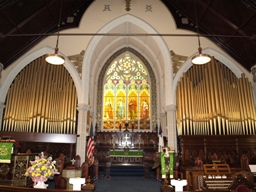 From its founding in 1762 to today Zion’s Reformed UCC Church has witnessed many changes. Rev Bob Stevens and Lehigh Valley Historian Frank Whelan combined for an interesting and informative presentation and tour last week. If you didn't take the tour and there's enough interest, maybe Rev. Bob can arrange another post meeting tour in 2018? We had a large turnout, but for those of you who might have missed it, here's the text of the talk and some more photos.
From its founding in 1762 to today Zion’s Reformed UCC Church has witnessed many changes. Rev Bob Stevens and Lehigh Valley Historian Frank Whelan combined for an interesting and informative presentation and tour last week. If you didn't take the tour and there's enough interest, maybe Rev. Bob can arrange another post meeting tour in 2018? We had a large turnout, but for those of you who might have missed it, here's the text of the talk and some more photos.ZION’S CHURCH PAST AND PRESENT
By Frank Whelan
If Zion’s Church seems like it has been here forever it almost has. In Lehigh Valley history terms and particularly in Allentown terms its roots are deep. It was in 1762 that William Allen donated land on the east side of Church Alley. Now Church Street. most probably located in the rear of the lot occupied by the parking garage. The space on which the church occupies today was apparently planned for a cemetery but was never used as one.
The first building was built of logs and was a union church used by both Reformed and Lutheran congregations. And we have the Lutheran pastor Rev. John Joseph Roth who on October 10, 1764 was surprised “and had to quit making my Sermon” when a crowd of settlers came flooding into the church out of fear of an Indian attack.
The previous August a party of native Americans had been cheated out of their furs at an inn located several miles north of Bethlehem. On October 8 the retaliated by attacking settlers in the vicinity of Whitehall which left 20 dead and sparked others to flee to the protection of the church. Though the governor called out the militia, the Native Americans, having made their point never returned.
One point should be made here. Both the Reformed and Lutheran congregations were us to having an educated clergy in Europe. There churches were founded by their rulers. So the first Reformed pastor John Peter Gross who served from 1765-1770 had been educated at Marburg and Heidelberg in Germany.
 His successor the Reverend Abraham Blumer (1770-1801) was to oversee the building of the second church. Money for the church was raised by holding a lottery. The old log building was turned over to the Lutheran who used it as a church until 1794 when the erected the first St. Paul’s Lutheran at 8thh and Walnut. Its logs and nails were sold at auction to a gentleman named Valentine Fatzinger for 17 pounds.
His successor the Reverend Abraham Blumer (1770-1801) was to oversee the building of the second church. Money for the church was raised by holding a lottery. The old log building was turned over to the Lutheran who used it as a church until 1794 when the erected the first St. Paul’s Lutheran at 8thh and Walnut. Its logs and nails were sold at auction to a gentleman named Valentine Fatzinger for 17 pounds. In 1773 a substantial stone structure was erected. It was not elegant but in size and fashion it would certainly have been at home among the Reformed churches of Philadelphia at the time. It was to serve the congregation into the 1830s. It was here the State House Bell that we have come to call the Liberty Bell was hidden from the British. It was also used as a hospital.
When we use the word hospital it was nothing like what it means today. Imagine soldiers dying on pews as they bled and doctors thinking they were helping them bled them some more with leeches or wrapped them in barely clean bandages. Pastor Blumer was supportive of the Revolutionary cause and spoke at local meetings where it was advocated.
Perhaps the most important thing about the church was its bell. Given to the church in 1769 Leonhardt Abel and Salome Abel it was created by Matthias Tommerop a Danish born Moravian bell maker from Bethlehem. It was almost undoubtedly rung when the Declaration of Independence was publicly read here in 1776.
Into the 1830s the old church served the congregation well. But the large increase in Allentown’s population led church leaders to see there was need for a chance. So in 1837 plans for the third church were drawn up. Finished and dedicated in 1840 it was a Georgian style red brick building that could have graced any New England green. It was from this church that the First Defenders were sent off to Washington D.C. to protect the capital at the start of the Civil War.
It is Zion’s 7th pastor the Rev. Edwin A. Gernant who is largely responsible for the 4th and final Zion Church that you see today. A gem of Victorian Gothic was the product of his work and the co-operation of the Consistory. Some call the 1880s the golden age of church building in America. Many Protestant churches in England and America wanted to enrich the worship service by adding stained glass windows and ornate religious furniture. Rev Gernant was in full sympathy with this movement. Discussion was begun in 1884 and in 1886 Lewis Jacoby, Allentown leading architect to design the sanctuary. About one saving grace with the Jacoby was that he was a Methodist and neither Reformed or Lutheran could claim there was favoritism involved.
of his work and the co-operation of the Consistory. Some call the 1880s the golden age of church building in America. Many Protestant churches in England and America wanted to enrich the worship service by adding stained glass windows and ornate religious furniture. Rev Gernant was in full sympathy with this movement. Discussion was begun in 1884 and in 1886 Lewis Jacoby, Allentown leading architect to design the sanctuary. About one saving grace with the Jacoby was that he was a Methodist and neither Reformed or Lutheran could claim there was favoritism involved.
 of his work and the co-operation of the Consistory. Some call the 1880s the golden age of church building in America. Many Protestant churches in England and America wanted to enrich the worship service by adding stained glass windows and ornate religious furniture. Rev Gernant was in full sympathy with this movement. Discussion was begun in 1884 and in 1886 Lewis Jacoby, Allentown leading architect to design the sanctuary. About one saving grace with the Jacoby was that he was a Methodist and neither Reformed or Lutheran could claim there was favoritism involved.
of his work and the co-operation of the Consistory. Some call the 1880s the golden age of church building in America. Many Protestant churches in England and America wanted to enrich the worship service by adding stained glass windows and ornate religious furniture. Rev Gernant was in full sympathy with this movement. Discussion was begun in 1884 and in 1886 Lewis Jacoby, Allentown leading architect to design the sanctuary. About one saving grace with the Jacoby was that he was a Methodist and neither Reformed or Lutheran could claim there was favoritism involved. The cornerstone was laid on August 22, 1886. Among the innovations were the curved sitting arrangement that replaced the straight backed pews and the elaborate pulpit and ecclesiastical furniture.
Perhaps the focal point of the church is the four large stained glass windows of the Apostles in the pulpit recess. They are said by some critics to be Munich Glass produced in that German city from the late 19th into the early 20th century. Until they were bombed out of existence in World War II they supply glass receiving orders from all over the world.
It should have come to no surprise, considering his interest in high church furniture that in 1890 Rev, Gernant was discovered to be attending evening services at an Episcopal Church. He resigned from Zions and eventually became an Episcopal minister. Perhaps we should not be too hard on him considering the wonderful legacy he has left in the beautiful sanctuary.

